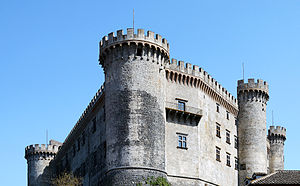
The House of Orsini is an Italian noble family that was one of the most influential princely families in medieval Italy and Renaissance Rome. Members of the Orsini family include five popes: Stephen II (752–757), Paul I (757–767), Celestine III (1191–1198), Nicholas III (1277–1280), and Benedict XIII (1724–1730). The family also included 34 cardinals, numerous condottieri, and other significant political and religious figures.

The House of Torlonia is the name of an Italian princely family from Rome, which acquired a huge fortune in the 18th and 19th centuries through administering the finances of the Vatican. The first influential member of the Torlonia family was Marino Torlonia, who rose from humble origins in the Auvergne region of France to become a very rich businessman and banker in Rome.

Bracciano is a small town in the Italian region of Lazio, 30 kilometres northwest of Rome. The town is famous for its volcanic lake and for a particularly well-preserved medieval castle Castello Orsini-Odescalchi. The lake is widely used for sailing and is popular with tourists; the castle has hosted a number of events, especially weddings of actors and singers.

The House of Erba-Odescalchi and the House of Odescalchi are branches of an Italian noble family formed by the union of the Erba and Odescalchi families. The Odescalchi family was, since the election of Benedetto Odescalchi as Pope Innocent XI in 1676, part of the highest Roman aristocracy.

Trevignano Romano is a small town and comune in the Metropolitan City of Rome, Lazio, central Italy. With a population of about 5,000, it is located on the volcanic Lake Bracciano. It is about 47 kilometres (29 mi) away from Rome.
The War of Ferrara was fought in 1482–1484 between Ercole I d'Este, Duke of Ferrara, and the Papal forces mustered by Ercole's personal nemesis, Pope Sixtus IV and his Venetian allies. Hostilities ended with the Treaty of Bagnolo, signed on 7 August 1484.

Raffaele Sansoni Galeoti Riario was an Italian Cardinal of the Renaissance, mainly known as the constructor of the Palazzo della Cancelleria and the person who invited Michelangelo to Rome. He was a patron of the arts. He was also the first adolescent to be elevated in the College of Cardinals in the history of the Holy See.
Gentile Virginio Orsini was an Italian condottiero and vassal of the papal throne and the Kingdom of Naples, mainly remembered as the powerful head of the Orsini family during its feud with Pope Alexander VI. Though best known as Lord of Bracciano, during his lifetime he bore many titles, among which Count of Tagliacozzo, Vicovaro and Anguillara, Lord of Cerveteri, Knight of the Order of Emellino (1463), Constable of the Kingdom of Naples and Gonfalonier of the Roman Church. The aforesaid fiefs were all confiscated in favor of the Colonna or the Borgia family during Virginio's conflict with Naples and the Pope.

Paolo Giordano Orsini was an Italian nobleman, and the first duke of Bracciano from 1560. He was a member of the Roman family of the Orsini.
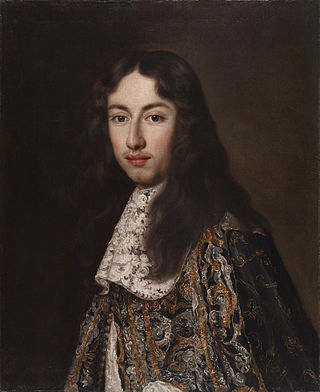
Livio Odescalchi, Duke of Bracciano, Ceri and Sirmium, was an Italian nobleman of the Odescalchi family.
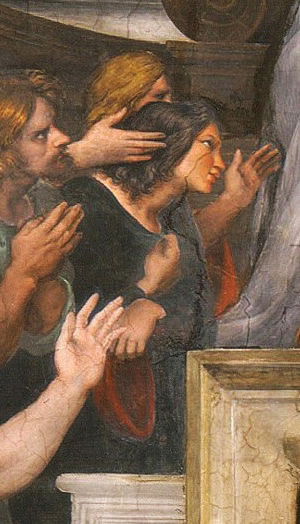
Felice della Rovere, also known as Madonna Felice, was the illegitimate daughter of Pope Julius II. One of the most powerful women of the Italian Renaissance, she was born in Rome around 1483 to Lucrezia Normanni and Cardinal Giuliano della Rovere. Felice was well educated, became accepted into close courtly circles of aristocratic families, and formed friendships with scholars and poets through her education and genuine interest in humanism. Through the influence of her father, including an arranged marriage to Gian Giordano Orsini, she wielded extraordinary wealth and influence both within and beyond the Roman Curia. In particular, she negotiated peace between Julius II and the Queen of France, and held the position of Orsini Signora for over a decade following the death of her husband in 1517. Felice further increased her power through a castle that she bought with money received from her father, the Castle at Palo, and through her involvement in the grain trade.
Cosma Orsini was an Italian Roman Catholic bishop and cardinal.
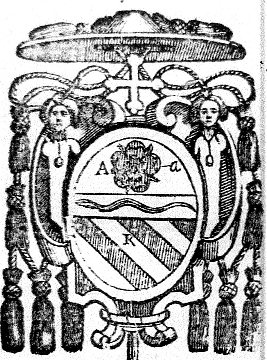
Giambattista Orsini was an Italian Roman Catholic cardinal. He served as papal legate to the Marches of Ancona.

Medici is a historical drama television series created by Frank Spotnitz and Nicholas Meyer. The series was produced by Italian companies Lux Vide and Rai Fiction, in collaboration with Spotnitz's Big Light Productions. The series follows the House of Medici, bankers of the Pope, in 15th-century Florence. Each season follows the events of a particular moment of the family's history exploring the political and artistic landscape of Renaissance Italy.
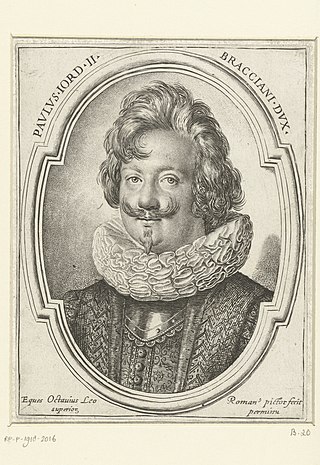
Paolo Giordano II Orsini was an Italian nobleman, Patron of arts, poet, and amateur painter.
The Duchy of Bracciano was a fief of the Papal States, centred on lago di Bracciano and the town of Bracciano itself and ruled by a branch of the Orsini family with the title of Lord and Duke (1560–1696).
Odescalchi is a surname of Italian origin. It may refer to:
Paolo Orsini was an Italian condottiero in the service of the Papal States, Ferdinand of Aragon and the Republic of Florence. He was marquess of Atripalda and lord of Mentana, Palombara Sabina and Selci.

Gian Giordano Orsini, IV Lord of Bracciano was an Italian nobleman and condottiero. He married Felice della Rovere and was the son-in-law of Pope Julius II.
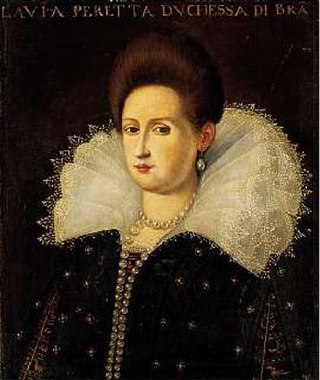
Flavia Damasceni Peretti, Duchess of Bracciano was an Italian noblewoman, niece of Pope Sixtus V and duchess consort of Bracciano as wife of Virginio Orsini. She is also known as the patroness of several poets, writers and musicians.
